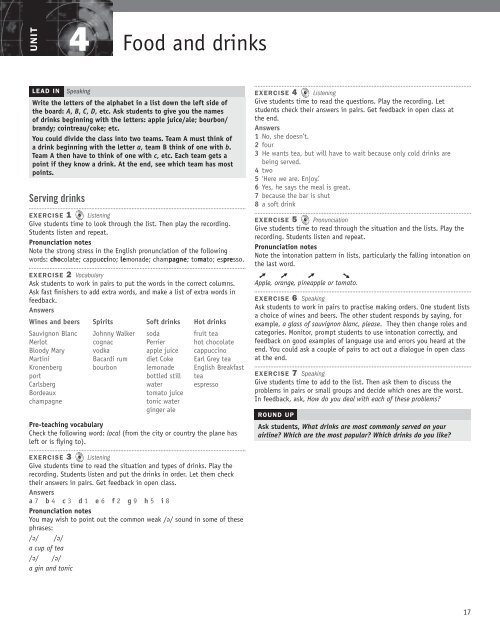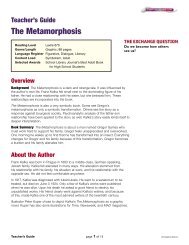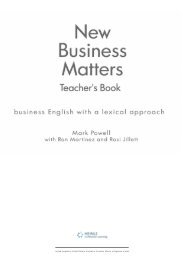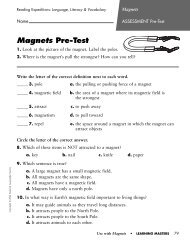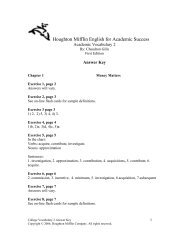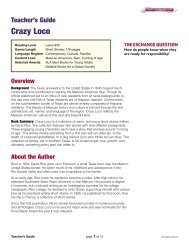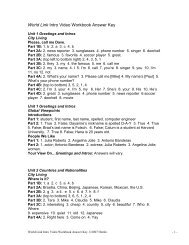English for Cabin Crew Trainer's Guide - Heinle
English for Cabin Crew Trainer's Guide - Heinle
English for Cabin Crew Trainer's Guide - Heinle
You also want an ePaper? Increase the reach of your titles
YUMPU automatically turns print PDFs into web optimized ePapers that Google loves.
UNIT<br />
4 Food and drinks<br />
LEAD IN Speaking<br />
Write the letters of the alphabet in a list down the left side of<br />
the board: A, B, C, D, etc. Ask students to give you the names<br />
of drinks beginning with the letters: apple juice/ale; bourbon/<br />
brandy; cointreau/coke; etc.<br />
You could divide the class into two teams. Team A must think of<br />
a drink beginning with the letter a, team B think of one with b.<br />
Team A then have to think of one with c, etc. Each team gets a<br />
point if they know a drink. At the end, see which team has most<br />
points.<br />
Serving drinks<br />
EXERCISE 1 Listening<br />
Give students time to look through the list. Then play the recording.<br />
Students listen and repeat.<br />
Pronunciation notes<br />
Note the strong stress in the <strong>English</strong> pronunciation of the following<br />
words: chocolate; cappuccino; lemonade; champagne; tomato; espresso.<br />
EXERCISE 2 Vocabulary<br />
Ask students to work in pairs to put the words in the correct columns.<br />
Ask fast fi nishers to add extra words, and make a list of extra words in<br />
feedback.<br />
Answers<br />
Wines and beers Spirits Soft drinks Hot drinks<br />
Sauvignon Blanc<br />
Merlot<br />
Bloody Mary<br />
Martini<br />
Kronenberg<br />
port<br />
Carlsberg<br />
Bordeaux<br />
champagne<br />
Johnny Walker<br />
cognac<br />
vodka<br />
Bacardi rum<br />
bourbon<br />
soda<br />
Perrier<br />
apple juice<br />
diet Coke<br />
lemonade<br />
bottled still<br />
water<br />
tomato juice<br />
tonic water<br />
ginger ale<br />
fruit tea<br />
hot chocolate<br />
cappuccino<br />
Earl Grey tea<br />
<strong>English</strong> Breakfast<br />
tea<br />
espresso<br />
Pre-teaching vocabulary<br />
Check the following word: local (from the city or country the plane has<br />
left or is fl ying to).<br />
EXERCISE 3 Listening<br />
Give students time to read the situation and types of drinks. Play the<br />
recording. Students listen and put the drinks in order. Let them check<br />
their answers in pairs. Get feedback in open class.<br />
Answers<br />
a 7 b 4 c 3 d 1 e 6 f 2 g 9 h 5 i 8<br />
Pronunciation notes<br />
You may wish to point out the common weak /@/ sound in some of these<br />
phrases:<br />
/@/ /@/<br />
a cup of tea<br />
/@/ /@/<br />
a gin and tonic<br />
EXERCISE 4 Listening<br />
Give students time to read the questions. Play the recording. Let<br />
students check their answers in pairs. Get feedback in open class at<br />
the end.<br />
Answers<br />
1 No, she doesn’t.<br />
2 four<br />
3 He wants tea, but will have to wait because only cold drinks are<br />
being served.<br />
4 two<br />
5 ‘Here we are. Enjoy.’<br />
6 Yes, he says the meal is great.<br />
7 because the bar is shut<br />
8 a soft drink<br />
EXERCISE 5 Pronunciation<br />
Give students time to read through the situation and the lists. Play the<br />
recording. Students listen and repeat.<br />
Pronunciation notes<br />
Note the intonation pattern in lists, particularly the falling intonation on<br />
the last word.<br />
➚ ➚ ➚ ➘<br />
Apple, orange, pineapple or tomato.<br />
EXERCISE 6 Speaking<br />
Ask students to work in pairs to practise making orders. One student lists<br />
a choice of wines and beers. The other student responds by saying, <strong>for</strong><br />
example, a glass of sauvignon blanc, please. They then change roles and<br />
categories. Monitor, prompt students to use intonation correctly, and<br />
feedback on good examples of language use and errors you heard at the<br />
end. You could ask a couple of pairs to act out a dialogue in open class<br />
at the end.<br />
EXERCISE 7 Speaking<br />
Give students time to add to the list. Then ask them to discuss the<br />
problems in pairs or small groups and decide which ones are the worst.<br />
In feedback, ask, How do you deal with each of these problems?<br />
ROUND UP<br />
Ask students, What drinks are most commonly served on your<br />
airline? Which are the most popular? Which drinks do you like?<br />
17


